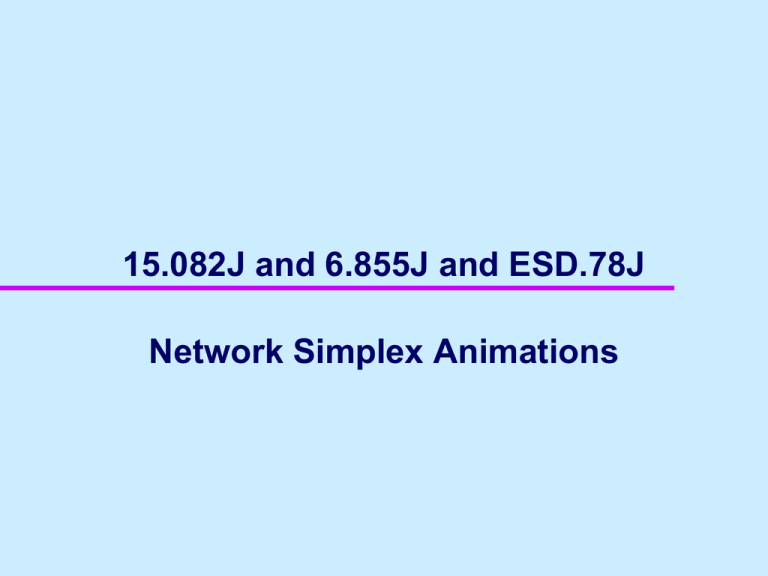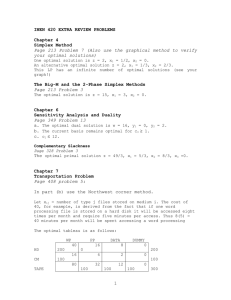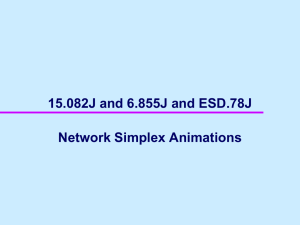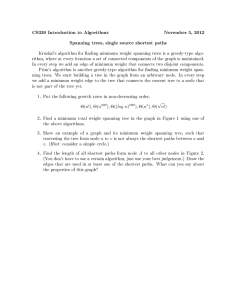15.082J and 6.855J and ESD.78J Network Simplex Animations
advertisement

15.082J and 6.855J and ESD.78J Network Simplex Animations Calculating A Spanning Tree Flow 1 1 -6 2 1 2 4 3 7 3 A tree with supplies and demands. (Assume that all other arcs have a flow of 0) 6 -4 5 3 What is the flow in arc (4,3)? 2 Calculating A Spanning Tree Flow 1 1 -6 2 1 3 4 3 6 -4 2 2 7 To calculate flows, iterate up the tree, and find an arc whose flow is uniquely determined. 5 3 What is the flow in arc (5,3)? 3 Calculating A Spanning Tree Flow 1 1 -6 2 1 2 2 4 3 What is the flow in arc (3,2)? 7 3 6 -4 3 5 3 4 Calculating A Spanning Tree Flow 1 1 -6 2 What is the flow in arc (2,6)? 7 3 6 1 2 2 4 3 6 -4 3 5 3 5 Calculating A Spanning Tree Flow 1 1 -6 2 6 1 2 2 4 What is the flow in arc (7,1)? 7 3 4 3 6 -4 3 5 3 6 Calculating A Spanning Tree Flow 1 1 What is the flow in arc (1,6)? 3 -6 2 6 1 2 2 4 7 3 4 3 6 -4 3 5 3 7 Calculating A Spanning Tree Flow 1 1 4 3 -6 2 6 1 2 2 4 7 3 4 3 6 -4 3 Note: there are two different ways of calculating the flow on (1,2), and both ways give a flow of 4. Is this a coincidence? 5 3 8 Calculating Simplex Multipliers for a Spanning Tree 1 5 -6 2 -4 3 3 -2 4 7 6 1 5 Here is a spanning tree with arc costs. How can one choose node potentials so that reduced costs of tree arcs is 0? Recall: the reduced cost of (i,j) is cij - πi + πj 9 Calculating Simplex Multipliers for a Spanning Tree 0 1 5 -6 2 -4 3 3 -2 4 7 6 There is a redundant constraint in the minimum cost flow problem. One can set π1 arbitrarily. We will let πi = 0. 1 5 What is the simplex multiplier for node 2? 10 Calculating Simplex Multipliers for a Spanning Tree 0 1 5 -6 -5 2 -4 3 3 -2 4 The reduced cost of (1,2) is c12 - π1 + π2 = 0. 7 Thus 5 - 0 + π2 = 0. 6 1 5 What is the simplex multiplier for node 7? 11 Calculating Simplex Multipliers for a Spanning Tree 0 1 5 -6 -5 2 -4 3 3 -2 4 The reduced cost of (1,2) is c71 - π7 + π1 = 0. 7 -6 Thus -6 - π2 +0 = 0. 6 1 5 What is the simplex multiplier for node 3? 12 Calculating Simplex Multipliers for a Spanning Tree 0 1 5 -6 -5 2 -4 3 -2 3 -2 4 7 -6 6 1 5 What is the simplex multiplier for node 6? 13 Calculating Simplex Multipliers for a Spanning Tree 5 0 1 -6 -5 2 -4 3 -2 3 -2 4 7 -6 6 -1 1 5 What is the simplex multiplier for node 4? 14 Calculating Simplex Multipliers for a Spanning Tree 5 0 1 -6 -5 2 -4 3 -2 3 -2 -4 4 7 -6 6 -1 1 5 What is the simplex multiplier for node 5? 15 Calculating Simplex Multipliers for a Spanning Tree 0 1 5 -6 -5 2 -4 3 -2 3 -2 -4 4 7 -6 6 -1 These are the simplex multipliers associated with this tree. They do not depend on arc flows, nor on costs of non-tree arcs. 1 5 -1 16 Network Simplex Algorithm 2 1 4, $1 2 -4 4 2, $4 4, $2 3, $5 3, $4 3 1, $4 5, $5 5 T L U 4, $2 5 -3 The minimum Cost Flow Problem 17 Spanning tree flows 2 1 0 1 1 3 3 2 2 -4 4 0 3 5 T L U 0 5 -3 An Initial Spanning Tree Solution 18 Simplex Multipliers and Reduced Costs 0 1 -2 2 0 0 3 3 0 2 T L U -4 4 4 0 3 The initial simplex multipliers and reduced costs ? 5 -2 c45 = 2 What arcs are violating? 19 Add a violating arc to the spanning tree, creating a cycle u14, x14 2, 1 1 4,0 4,1 3,2 2 3,3 3 1, 0 5, 3 Arc (2,1) is added to the tree T L U 4 4, 0 5 What is the cycle, and how much flow can be sent? 20 Send Flow Around the Cycle u14, x14 2, 1 1 4,2 4,3 3,0 2 3,3 3 1, 0 5, 3 2 units of flow were sent along the cycle. T L U 4 4, 0 5 What is the next spanning tree? 21 After a pivot u14, x14 2, 1 1 4,2 4,3 3,0 2 3,3 3 1, 0 5, 3 The Updated Spanning Tree T L U 4 4, 0 5 In a pivot, an arc is added to T and an arc is dropped from T. 22 Updating the Multipliers 0 1 -2 0 0 3 3 0 2 2 4 0 3 The current multipliers and reduced costs -4 4 T L U 4 5 -2 How can we make c21 = 0 and have other tree arcs have a 0 reduced cost? 23 Deleting (2,1) from T splits T into two parts 0 1 -2 0 0 3 3 0 2 2 4 0 3+Δ Adding Δ to multipliers on one side of the tree does not effect the reduced costs of any tree arc except (2,1). Why? -4 4 T L U 4 5 -2+Δ What value of Δ should be chosen to make the reduced cost of (2,1) = 0? 24 The updated multipliers and reduced costs 0 1 0 0 0 3 3 2 2 2 2 0 1 The updated multipliers and reduced costs -4 4 T L U 2 5 -4 Is this tree solution optimal? 25 Add a violating arc to the spanning tree, creating a cycle T L U 2, 1 1 4,2 4,3 3,0 2 3,3 3 1, 0 5, 3 Add arc (3,4) to the spanning tree 4 4, 0 5 What is the cycle, and how much flow can be sent? 26 Send Flow Around the Cycle T L U 2, 2 1 4,2 4,2 3,0 2 3,2 3 1, 0 5, 3 1 unit of flow was sent around the cycle. 4 4, 0 5 What is the next spanning tree solution? 27 The next spanning tree solution T L U 2, 2 1 4,2 4,2 3,0 2 3,2 3 1, 0 5, 3 4 4, 0 5 Here is the updated spanning tree solution 28 Updated the multipliers 0 1 0 0 0 3 3 2 2 0 1 Here are the current multipliers 2 2 -4 4 T L U 2 5 -4 How should we modify the multipliers? 29 Updated the multipliers 0 1 0 0 0 3 3 2 2 0 1 2 2 -4 +Δ 4 T L U 2 5 -4 What value should Δ be? Here are the current multipliers 30 The updated multipliers 0 1 0 -2 0 3 3 2 2 0 0 1 Here are the updated multipliers. 2 -6 4 T L U 4 5 -4 Is the current spanning tree solution optimal? 31 The Optimal Solution 0 1 0 -2 0 3 3 2 2 0 2 0 1 Here is the optimal solution. -6 4 T L U 4 5 -4 No arc violates the optimality conditions. 32 Finding the Cycle 1 8 3 10 7 2 6 11 9 12 5 33 Use Depth and Predecessor 0 1 8 7 depth(5) = 4; 2 10 3 11 depth(3) = 2; 2 6 9 12 5 replace node 5 by pred(5) 4 34 Use Depth and Predecessor 0 1 8 7 depth(9) = 3; 2 10 3 6 11 depth(3) = 2; 2 9 3 12 replace node 9 by pred(9) 5 35 Use Depth and Predecessor 0 1 8 7 depth(2) = 2; 2 10 3 11 depth(3) = 2; 2 2 6 9 12 5 replace node 2 by pred(2); replace node 3 by pred(3) 36 Use Depth and Predecessor 0 1 1 7 1 8 depth(8) = 1; 3 10 11 depth(7) = 1; 2 6 9 12 5 replace node 8 by pred(8); replace node 7 by pred(1) 37 Use Depth and Predecessor 0 1 8 3 10 7 2 6 11 9 12 The least common ancestor of nodes 3 and 5 has been found. 5 38 Updating the multipliers: use the thread and depth 1 8 3 10 7 2 6 11 9 12 Suppose that arc (1,8) will drop out of the tree. What is the subtree rooted at node 8? 5 39 Follow the thread starting with node 8 1 8 3 10 What is thread(8)? 7 2 6 11 9 12 5 40 Follow the thread starting with node 8 1 8 3 10 What is thread(3)? 7 2 6 11 9 12 5 41 Follow the thread starting with node 8 1 8 3 10 What is thread(10)? 7 2 6 11 9 12 5 42 Follow the thread starting with node 8 1 8 3 10 What is thread(11)? 7 2 6 11 9 12 5 43 Follow the thread starting with node 8 1 8 3 10 What is thread(6)? 7 2 6 11 9 12 5 44 The stopping rule 1 depth = 1 8 3 10 6 11 Stopping rule: stop when depth(current node) ≤ depth(8) 7 depth = 1 2 9 12 5 45 MITOpenCourseWare http://ocw.mit.edu 15.082J / 6.855J / ESD.78J Network Optimization Fall 2010 For information about citing these materials or our Terms of Use, visit: http://ocw.mit.edu/terms.



